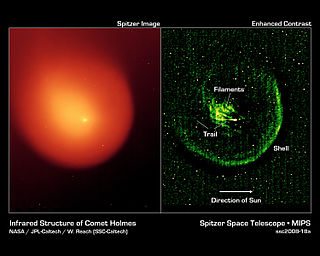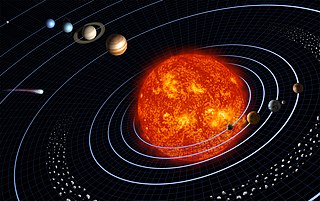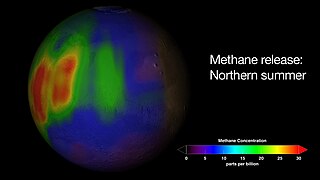
Michael J. Mumma is an American astrobiologist at the Goddard Space Flight Center; he is best known for his investigation of the chemistry of comets.

Michael J. Mumma is an American astrobiologist at the Goddard Space Flight Center; he is best known for his investigation of the chemistry of comets.
Mumma graduated Franklin and Marshall College in 1963, with an A.B. in physics. He received a Ph.D. in physics from the University of Pittsburgh in 1970, and joined NASA's GSFC thereafter.
Mumma is the founding director of the Goddard Center for Astrobiology (2003–present) and Senior Scientist in the Solar System Exploration Division (2005–present). [1] He has had adjunct professorships at Pennsylvania State University, University of Toledo and University of Maryland during his tenure with GFSC. [1]
Mumma's major research interests have been largely directed towards understanding life's origin and its distribution in the cosmos through the study of planetary and cometary chemistry. Mumma pioneered the first detection of water in comets. [2] Using similar spectrometric methodology Mumma has identified many other gaseous species found in comets. [3] He posits that it is possible that comets "seeded life" on the Earth, filling the oceans with water and essential molecular building blocks. [4] He uses information gleaned from Comet LINEAR showing the same isotopic composition as water on the Earth. [5] Recent cometary data on water confirms the data from Comet LINEAR. [6] For his longstanding contribution to planetary science, in 1999 the International Astronomical Union named asteroid 8340 "Michael J. Mumma". [7]
Mumma's group at GFSC was the first to report methane plumes on Mars, and suggested that pores in the soil might open only during certain seasons. [8] These findings have been recently confirmed. [9] [10] The source of the methane is still unresolved, whether it is geochemical or from living systems, which would indicate life on Mars. As far as further findings and conclusions, Mumma stated: "There will be surprising results." [11]
Mumma reports that the most important thing he does is working "intensely" with young scientists, exposing them to the "exciting" research at GFSC. [12] At Goddard, he has mentored 31 post-docs and senior visiting scientists and has codirected eight Ph. D. theses. [1]
So, every day brings something new to us. It's the newness, the continued discovery-rather small ones, larger ones, it doesn't matter, and in my view it's not work, you see. This is the way we spend our lives, in discovery, and this is an opportunity to continue doing that daily. [12]
In 2019 Mumma was part of the team that found water vapors on Europa. This is important as Europa is a prime target in looking for life forms in the solar system. [13]
Mumma appeared as himself in a 2007 episode of The Universe. [14]
Elected Fellow of the American Physical Society, 1990 [15]
NASA Exceptional Scientific Achievement Medal, 1997.
John C. Lindsay Memorial Award, 2009 [16]
NASA Distinguished Service Medal, 2020 [17]
Society of Distinguished Alumni, Franklin and Marshall College. [18]
8340 Mumma, minor planet named after him.

Astrochemistry is the study of the abundance and reactions of molecules in the universe, and their interaction with radiation. The discipline is an overlap of astronomy and chemistry. The word "astrochemistry" may be applied to both the Solar System and the interstellar medium. The study of the abundance of elements and isotope ratios in Solar System objects, such as meteorites, is also called cosmochemistry, while the study of interstellar atoms and molecules and their interaction with radiation is sometimes called molecular astrophysics. The formation, atomic and chemical composition, evolution and fate of molecular gas clouds is of special interest, because it is from these clouds that solar systems form.

Comet Hyakutake is a comet discovered on 31 January 1996. It was dubbed the Great Comet of 1996; its passage to within 0.1 AU (15 Gm) of the Earth on 25 March was one of the closest cometary approaches of the previous 200 years. Reaching an apparent visual magnitude of zero and spanning nearly 80°, Hyakutake appeared very bright in the night sky and was widely seen around the world. The comet temporarily upstaged the much anticipated Comet Hale–Bopp, which was approaching the inner Solar System at the time.

Stardust was a 385-kilogram robotic space probe launched by NASA on 7 February 1999. Its primary mission was to collect dust samples from the coma of comet Wild 2, as well as samples of cosmic dust, and return them to Earth for analysis. It was the first sample return mission of its kind. En route to Comet Wild 2, it also flew by and studied the asteroid 5535 Annefrank. The primary mission was successfully completed on 15 January 2006 when the sample return capsule returned to Earth.

The Goddard Space Flight Center (GSFC) is a major NASA space research laboratory located approximately 6.5 miles (10.5 km) northeast of Washington, D.C., in Greenbelt, Maryland, United States. Established on May 1, 1959 as NASA's first space flight center, GSFC employs about 10,000 civil servants and contractors. Named for American rocket propulsion pioneer Robert H. Goddard, it is one of ten major NASA field centers. GSFC is partially within the former Goddard census-designated place; it has a Greenbelt mailing address.

The Discovery Program is a series of Solar System exploration missions funded by the U.S. National Aeronautics and Space Administration (NASA) through its Planetary Missions Program Office. The cost of each mission is capped at a lower level than missions from NASA's New Frontiers or Flagship Programs. As a result, Discovery missions tend to be more focused on a specific scientific goal rather than serving a general purpose.
The possibility of life on Mars is a subject of interest in astrobiology due to the planet's proximity and similarities to Earth. To date, no conclusive evidence of past or present life has been found on Mars. Cumulative evidence suggests that during the ancient Noachian time period, the surface environment of Mars had liquid water and may have been habitable for microorganisms, but habitable conditions do not necessarily indicate life.

The coma is the nebulous envelope around the nucleus of a comet, formed when the comet passes near the Sun in its highly elliptical orbit. As the comet warms, parts of it sublimate; this gives a comet a diffuse appearance when viewed through telescopes and distinguishes it from stars. The word coma comes from the Greek κόμη (kómē), which means "hair" and is the origin of the word comet itself.
A biosignature is any substance – such as an element, isotope, molecule, or phenomenon – that provides scientific evidence of past or present life on a planet. Measurable attributes of life include its physical or chemical structures, its use of free energy, and the production of biomass and wastes.
New Millennium Program (NMP) was a NASA project with focus on engineering validation of new technologies for space applications. Funding for the program was eliminated from the FY2009 budget by the 110th United States Congress, effectively leading to its cancellation.

The atmosphere of Mars is the layer of gases surrounding Mars. It is primarily composed of carbon dioxide (95%), molecular nitrogen (2.85%), and argon (2%). It also contains trace levels of water vapor, oxygen, carbon monoxide, hydrogen, and noble gases. The atmosphere of Mars is much thinner and colder than Earth's having a max density 20g/m3 with a temperature generally below zero down to -60 Celsius. The average surface pressure is about 610 pascals (0.088 psi) which is 0.6% of the Earth's value.

The Mars general circulation model is the result of a research project by NASA to understand the nature of the general circulation of the atmosphere of Mars, how that circulation is driven and how it affects the climate of Mars in the long term.
Extraterrestrial liquid water is water in its liquid state that naturally occurs outside Earth. It is a subject of wide interest because it is recognized as one of the key prerequisites for life as we know it and is thus surmised to be essential for extraterrestrial life.

The study of extraterrestrial atmospheres is an active field of research, both as an aspect of astronomy and to gain insight into Earth's atmosphere. In addition to Earth, many of the other astronomical objects in the Solar System have atmospheres. These include all the giant planets, as well as Mars, Venus and Titan. Several moons and other bodies also have atmospheres, as do comets and the Sun. There is evidence that extrasolar planets can have an atmosphere. Comparisons of these atmospheres to one another and to Earth's atmosphere broaden our basic understanding of atmospheric processes such as the greenhouse effect, aerosol and cloud physics, and atmospheric chemistry and dynamics.

The ExoMars Trace Gas Orbiter is a collaborative project between the European Space Agency (ESA) and the Russian Roscosmos agency that sent an atmospheric research orbiter and the Schiaparelli demonstration lander to Mars in 2016 as part of the European-led ExoMars programme.

Goddard Space Flight Center (GSFC) is NASA's first, and oldest, space center. It is named after Robert H. Goddard, the father of modern rocketry. Throughout its history, the center has managed, developed, and operated many notable missions, including the Cosmic Background Explorer, the Hubble Space Telescope, the Tracking and Data Relay Satellite System (TDRSS), the Lunar Reconnaissance Orbiter, and the Solar Dynamics Observatory.

An extinct comet is a comet that has expelled most of its volatile ice and has little left to form a tail and coma. In a dormant comet, rather than being depleted, any remaining volatile components have been sealed beneath an inactive surface layer.

Geronimo L. Villanueva is a planetary astronomer at NASA Goddard Space Flight Center. Some of his contributions include the identification of an ancient ocean on Mars, sensitive searches of primordial water in comets, and the search and possible discovery of organics on Mars. His work on high-resolution molecular spectroscopy of planetary and cometary atmospheres led the International Astronomical Union to name minor planet 9724 after Villanueva, while the American Astronomical Society awarded him the Urey Prize in 2015.

The reported presence of methane in the atmosphere of Mars is of interest to many geologists and astrobiologists, as methane may indicate the presence of microbial life on Mars, or a geochemical process such as volcanism or hydrothermal activity.

Lynnae C. Quick is an American planetary geophysicist and Ocean Worlds Planetary Scientist at NASA Goddard Space Flight Center. Her research centers on theoretical modeling of cryovolcanic processes on the icy moons and dwarf planets in the Solar System as well as modeling volcanic activity on Venus and the Moon. Quick is a member of the Dawn, Europa Clipper, and Dragonfly Mission science teams. She is also a member of the NASA Solar System Exploration Research Virtual Institute (SSERVI) Toolbox for Research and Exploration (TREX) team, and serves as co-chair of the Earth and Planetary Systems Sciences section of the National Society of Black Physicists.
{{cite web}}: CS1 maint: numeric names: authors list (link)